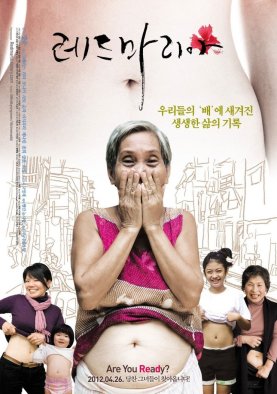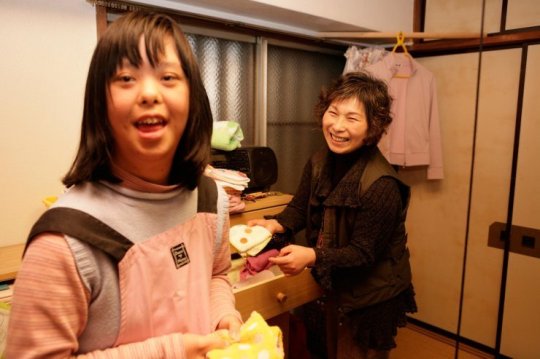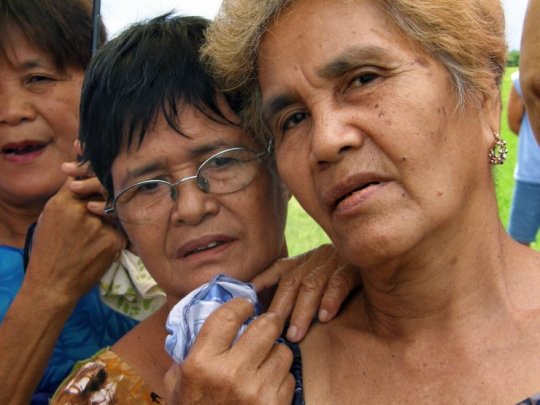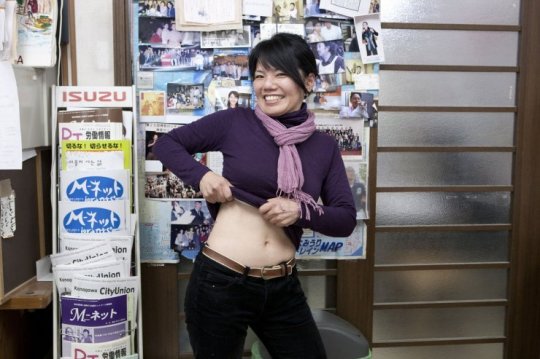아직도 난 이글을 읽지 못했다.ㅎ
Red Maria (레드 마리아) – 6/10
The dilemmas facing women in South-East Asian countries are multitudinous. Despite the great variety of countries within the region, and regardless of the diverse cultures and heritage, each nation has one thing in common – the dominance of patriarchy. As such the role of women as wives, mothers and homemakers has been, and continues to be, difficult to shift even though increasing numbers of women have entered the workplace. Interestingly this in itself is problematic in defining the term ‘labor’ in regards to females. Traditionally the word refers to employment in exchange for money and/or trade goods, but as females occupy such diverse roles the definition is difficult to clarify.
Director Kyung Soon (경순) attempts to address the quandary through her documentary Red Maria (레드 마리아). During the course of the film, the director explores the concept of women’s labor within South Korea, Japan, and The Philippines documenting the lives of a number of females each with her own struggles. From unfairly dismissed employees and care workers, to women working in the sex trade and the homeless, director Kyung Soon seeks to convey that while each of the females within are not connected physically, the trials they endure and their strength of character unite them spiritually in the struggle against oppressive patriarchy. Such an objective is incredibly ambitious, and while this does allow for a highly interesting documentary the sheer number of participants makes the film overstretched and lacking an emotional core, while the editing and other post-production techniques also detract from the experience.
In attempting to convey the daily struggles of South-East Asian women, director Kyung Soon deserves praise indeed as it is rarely touched upon in mainstream cinema. The concept of women’s labor and it’s definition is certainly intriguing given the variety of cultures and statuses within the region. However, her desire to capture so much information is also her undoing as the documentary is, while very interesting, lacking in focus. The multitude of characters that inhabit the film also suffer the same fate as while each person is intriguing, they are given only brief segments of time before the audience is whisked off to another location and situation.
This particularly applies to the women from The Philippines. The Filipino women are far and away the greatest assets of Red Maria (레드 마리아). Their stories are poignant and tender, and the sincerity of their emotions and their drive to continue on despite obstacles are the heart and soul of the film. The women profiled are those who have fallen outside the margins, those living in slums, working in the sex trade, and the elderly. Their stories are heart-breaking yet inspiring as they refuse to let the severity of their respective situations dampen their spirits. Scenes in which senior Filipino women describe the rape of an entire village decades before by Japanese soldiers cannot fail to shock, while the generations of women – within the same family – working in the sex trade is incredibly saddening. Likewise, the families living within the slums being forcefully evicted are compelling to say the least. Yet with each struggle there is hope due to the incredible resilience of the women involved, whether fighting for the truth and an apology, studying to change career, or even refusing to move, the Filipino women are inspiring in their strength and tenacity. These scenes also provide Red Maria (레드 마리아) with the greatest visuals throughout the film. Within the slums for example, a train passes mere inches from the abodes of those that reside there in comically stunning fashion. The senior women show the location of the mass rapes, a large red mansion in the country which is incredibly sinister and reminiscent of horror films. Their stories are the most compelling feature of Red Maria (레드 마리아), and had director Kyung Soon continued to follow their development the documentary would be much stronger for it.
However, as South Korean and Japanese women are also profiled the tone of the documentary consistently changes and is quite jarring. Alternating between these locations also unfairly lessons the impact and seriousness of those in Korea and Japan. While women in The Philippines struggle to survive, the women from other countries are protesting against unfair dismissal, working as care workers or travel agents, or living in a tent in the woods. Their situations are interesting and important in emphasizing alternative forms of patriarchal oppression, but it is impossible not to compare and contrast with the more uncompromising situations faced by their counterparts. It also doesn’t help that so little screen time is dedicated to them, nor that their innermost thoughts are not really revealed, making it difficult to empathize with the struggles they endure. There are also instances which beg for more insight that never appear, such as workers rights and governmental and police hostility towards demonstrators, the difficulties of living homeless, and being an immigrant bride. Such areas are never explored fully, to the detriment of empathizing with the plights the women face. Additionally some claims – such as South Korea not being ready to accept sex workers – are downright odd, considering the sheer number of Korean prostitutes that operate within the country.
Post-production is also an issue with Red Maria (레드 마리아). Generally the editing is competent, yet there are several instances in which the documentary appears to be winding towards a finale only to pick up again and continue on. Scenes such as young Filipino women playing on the beach are inserted yet serve no purpose. The use of text highly detracts from the film as well, as the variety of different fonts, the occasional appearance of the director’s thoughts, and some flashy graphic work often serve to pull the audience out of the film. One of the interesting highlights of the film is the frequent recurrence of women’s stomachs which are symbolic of numerous attributes of the term ‘labor’, but oddly the text is never used to explain the director’s thoughts on this issue.
Red Maria (레드 마리아) is a highly interesting documentary, and director Kyung Soon deserves praise indeed for attempting to profile the subjugation of women under oppressive patriarchy in South-East Asia. Yet her desire to explore the concept of women’s labor proves to be far too broad in scope, resulting in a lack of character and debate development, as well as audience empathy. Yet it is the Filipino women who are the genuine highlight of the film, bringing incredible poignancy and inspiration to the discussion, and make Red Maria (레드 마리아) worth watching.
'기사와 리뷰' 카테고리의 다른 글
| <KMDB 다큐초이스> 레드마리아 / 남다은 (0) | 2013.04.03 |
|---|---|
| 쥬드의 레드마리아 리뷰 (0) | 2012.12.27 |
| [review] 블로거 '송씨네'님의 < 레드마리아 > 리뷰_ 女子, 여자, babae(바바에)... 여자를 우리는 얼마나 알고 있나요? (0) | 2012.05.29 |
| [review] 블로거 '카제'님의 < 레드마리아 > 리뷰_ 컬쳐 쇼크! 여성 노동자의 '배'를 보다. (0) | 2012.05.21 |
| [review] 블로거 'Inny'님의 리뷰_< 레드마리아 >, 나에게 질문을 던지는 영화 (0) | 2012.05.17 |







